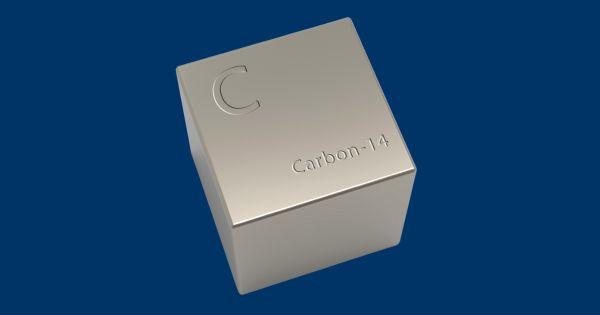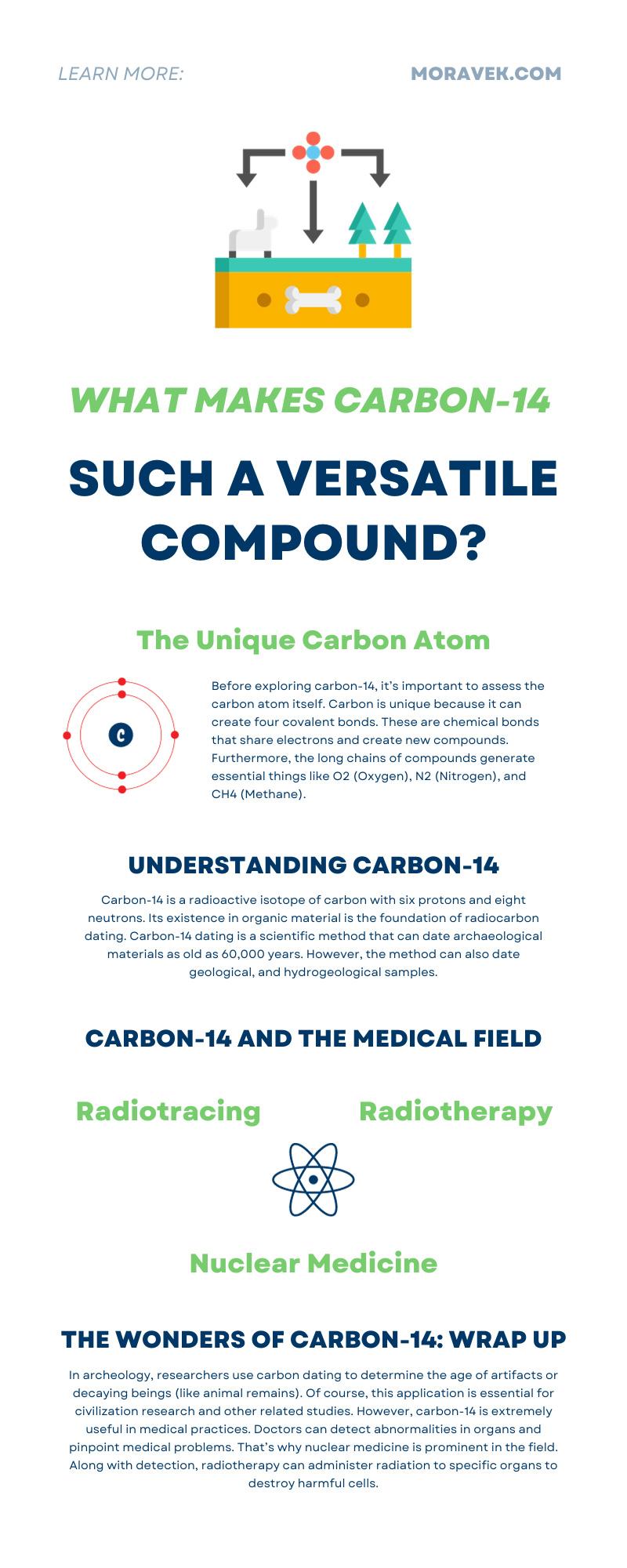
Some compounds are more complex and useful than others. Discover what makes carbon-14 such a versatile compound and its common applications. This essential information uncovers details about medical and civilization advancements!
The Unique Carbon Atom
Before exploring carbon-14, it’s important to assess the carbon atom itself. Carbon is unique because it can create four covalent bonds. These are chemical bonds that share electrons and create new compounds. Furthermore, the long chains of compounds generate essential things like O2 (Oxygen), N2 (Nitrogen), and CH4 (Methane).
Carbon is a versatile element because you can find it in various chemical compounds, including space. The atom can form single, double, and triple bonds. It can also make chains, branched chains, and rings when those bonds connect.
Carbon atoms bond strongly to other elements like hydrogen, oxygen, and nitrogen, and arrange in different ways. Some scientists refer to Carbon as “the backbone of life on Earth” as it connects with many things. There’s no other atom quite like this one!
Understanding Carbon-14
Carbon-14 is a radioactive isotope of carbon with six protons and eight neutrons. Its existence in organic material is the foundation of radiocarbon dating. Carbon-14 dating is a scientific method that can date archaeological materials as old as 60,000 years. However, the method can also date geological, and hydrogeological samples.
In simple terms, carbo dating is a strategy scientists use to calculate an item’s age by measuring the amount of radioactive carbon it holds. The less radioactivity it emits, the older it is. Vegetation and animals stop absorbing carbon-14 when they deteriorate. So, the residual carbon can reveal their age at the time of death.
Why Is It Important?
Radiocarbon dating is important because it lets scientists learn about past civilizations and changes in the earth and climate. Scientists and researchers can estimate different things about specific periods when they have the exact ages of materials. For example, scientists can determine the average life expectancy of past civilizations.
Concerning human health, radiocarbon isotopes help doctors study the human body, its functions, and diseases. Nuclear bomb testing in the 1950s and 1960s created more carbon-14 worldwide. So, scientists could track the development of diseases and evaluate disease progression. For example, they could look at Alzheimer’s plaques in a patient’s brain and determine how those plaques grew over time.
Radiocarbon isotopes can also monitor medication responses in the body. A modern application is cancer treatment responses. Oncologists can evaluate a patient’s response to chemotherapy, immunotherapy, or radiation, or understand how cancer metastasizes.
Carbon-14 and the Medical Field
The most recognizable isotope is carbon-14 because of its radioactivity. As mentioned, the scientific community uses carbon dating to determine the age of different objects. However, various archaeological and medical applications make carbon-14 such a versatile compound.
Nuclear Medicine
Nuclear medicine uses small amounts of radioactive materials, like carbon-14, to diagnose and treat different diseases. Nuclear medicine uncovers the cause of a medical diagnosis based on the function of an organ, tissue, or bone. This diagnosis is unlike other detection methods (i.e., X-rays, ultrasounds, and other diagnostic tests) because they detect the presence of diseases based on their structural appearance.
Moreover, nuclear medicine can treat some diseases. For instance, radiation targets and destroys diseased tissues. You’ll typically see radiation therapy applied to cancer patients as a treatment to remove cancerous cells and reduce the size of tumors.
Nuclear medicine is vital for patient care because it advances human health. The diagnosis and treatment capabilities are outstanding as doctors can reveal information about the function of organs, tissues, and cells. This type of medicine can detect abnormalities in an organ’s structure, and doctors can start preventative treatment for patients. Prevention is the best way to combat serious diseases and catch problems in the early stages.
Radiotracing and Radiotherapy
Medical researchers use radiolabeled pharmaceuticals for various reasons. That said, radiolabeled compounds play a crucial role in biomedical science progression. It’s important to understand that radioisotopes have two main functions—supplying radioactive energy or a radioactive tracer source.
Radioactive tracers help medical professionals identify target marker materials in the human body. They can detect the size, shape, and presence of abnormalities in organs. This detection method is how nuclear medicine comes into play.
Researchers utilize an injectable radiotracer, like a gamma-ray scanner or an imaging machine, to find and analyze different spots for diagnosis. Ultimately, it assists with pinpointing the exact location of diseases. So, doctors can generate specialized treatment for body parts.
Admittedly, radiotherapy is more complex than radiotracing. Radiotherapy is the calculation and administration of radiation doses through metabolic systems. Various treatments use radioisotopes to release intentional energy to the source of symptoms.
Proper energy release will change the molecular composition in targeted body cells, like reducing the size of tumors. Therefore, this version of nuclear medicine is a popular strategy for oncology. In fact, tons of successful cancer treatments are because of radioactivity!
Radiolabeled Manufacturing
Another outstanding radiolabeled compound application is radiolabeled manufacturing. Researchers can study absorption, distribution, and metabolism in human beings using this application. The data collection can explain a particular drug’s function and efficiency through its metabolic rate. Carbon-14 is a common label because it can provide a stable carbon presence on any molecule. Additionally, it is active enough for easy detection when scientists use standard techniques.
Regarding pharmaceuticals, the formulation of custom radiolabeled active pharmaceutical ingredients (APIs) is critical to the success of clinical trials. It’s the active component of a drug that generates the desired effect on the body to treat a condition. Radiolabeling expertise is crucial for manufacturing suitable carbon-14 compounds to use in clinical trials.
Production Services
Radiochemistry professionals (like Moravek) perform API pharmaceutical manufacturing for drug development and research. The complex process includes reaction, crystallization, solvent exchange, and other essential steps. Professionals acquire raw materials and chemical compounds to determine which combinations complement each other. Developers use radiolabeled compounds to monitor drug reactions and determine how effective they are for medical conditions.
It’s best to outsource production services because these companies comply with Current Good Manufacturing Practice (Cgmp) and generate the best samples. As a result, drug developers can use compounds for clinical and non-clinical research.
The Wonders of Carbon-14: Wrap Up
Carbon is an exceptional atom because it self-links (creates covalent bonds), and can bond with other elements (i.e., hydrogen). Carbon-14 is a radioactive isotope of carbon with six protons and eight neutrons, and has medical and archaeological purposes.
In archeology, researchers use carbon dating to determine the age of artifacts or decaying beings (like animal remains). Of course, this application is essential for civilization research and other related studies. However, carbon-14 is extremely useful in medical practices.
Doctors can detect abnormalities in organs and pinpoint medical problems. That’s why nuclear medicine is prominent in the field. Along with detection, radiotherapy can administer radiation to specific organs to destroy harmful cells.
All this to say, carbon-14 is versatile and beneficial!

